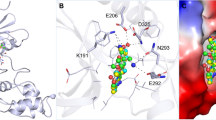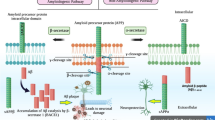Abstract
Classification of chemical compounds of plants as a source of medicaments for neurodegenerative diseases through computer screening is an efficient process in drug discovery, in advance of laboratory testing and clinical trials. The onset of neurodegenerative disorders incarcerates both sufferers and their families mentally and financially. This investigation emphasises the search for potent compounds via a computational approach, as an initial path towards the treatment of the neurodegenerative diseases Alzheimer’s (AD), Parkinson’s (PD), prion, and Huntington’s (HD) diseases. The therapeutic strategy considered here is chelation therapy, emanated from the heightened levels of metal ions, which play an imperative role in the pathogenesis of all four neurodegenerative disorders mentioned. Hence, potent compounds from Sri Lankan plants to function as lead compounds have been identified for Cu(II), Fe(III), Zn(II), and Al(III) ions, from a library of around 200 chemical compounds, using an umbrella sampling molecular dynamics computational approach where the chelating ability of compounds for the metal ion is assessed in terms of binding free energy. Calculations reveal that 12 Sri Lankan plants possess compounds that could be considered as starting points of leads for AD, PD and prion disease. However, no compound was potentially useful for the HD category, according to the study.
Graphic abstract
Potential of mean force of Al3+ binding to (–)-5-methylmellin found in Semecarpus walkeri with two representative configurations.







Similar content being viewed by others
References
Przedborski S, Vila M, Jackson-Lewis V (2003) Series introduction: neurodegeneration: what is it and where are we? J Clin Invest 111(1):3–10. https://doi.org/10.1172/JCI17522
Brown RC, Lockwood AH, Sonawane BR (2005) Neurodegenerative diseases: an overview of environmental risk factors. Environ Health Perspect 113(9):1250–1256. https://doi.org/10.1289/ehp.7567
World Health Organization (2006) Neurological disorders: public health challenges. World Health Organization, Geneva
Sheikh S, Haque E, Mir SS (2013) Neurodegenerative diseases: multifactorial conformational diseases and their therapeutic interventions. J Neurodegener Dis 2013:1–8. https://doi.org/10.1155/2013/563481
Tutar Y, Ozgür A, Tutar L (2013) Role of protein aggregation in neurodegenerative diseases. In: Kishore U (ed) neurodegenerative diseases. IntechOpen, London
Treusch S, Cyr DM, Lindquist S (2009) Amyloid deposits: protection against toxic protein species? Cell Cycle 8(11):1668–1674. https://doi.org/10.4161/cc.8.11.8503
Bhatia KP, Schneider S (2013) Metal related neurodegenerative disease. Academic Press, Cambridge
Crichton R, Ward R (2013) Metal-based neurodegeneration: from molecular mechanisms to therapeutic strategies. Wiley, Hoboken
Viles JH (2012) Metal ions and amyloid fiber formation in neurodegenerative diseases. Copper, zinc and iron in Alzheimer's, Parkinson's and prion diseases. Coord Chem Rev 256(19–20):2271–2284. https://doi.org/10.1016/j.ccr.2012.05.003
Butterfield DA, Kanski J (2001) Brain protein oxidation in age-related neurodegenerative disorders that are associated with aggregated proteins. Mech Ageing Dev 122(9):945–962. https://doi.org/10.1016/S0047-6374(01)00249-4
Gaeta A, Hider RC (2005) The crucial role of metal ions in neurodegeneration: the basis for a promising therapeutic strategy. Br J Pharmacol 146(8):1041–1059. https://doi.org/10.1038/sj.bjp.0706416
Rathnayake S, Weerasinghe S (2018) Development of an information system of structures and force field parameters of chemical compounds from Sri Lankan Flora. Comb Chem High Throughput Screen 21(8):550–556. https://doi.org/10.2174/1386207321666181010113533
Kästner J (2011) Umbrella sampling. Wiley Interdiscip Rev Comput Mol Sci 1(6):932–942. https://doi.org/10.1002/wcms.66
Tejchman W, Żesławska E, Zborowski K, Nitek W, Żylewski M (2015) The synthesis, molecular structure and spectra properties of sulfur and selenium deferiprone analogues. Arkivoc 2015(7):216–230. https://doi.org/10.3998/ark.5550190.p009.262
Schüttelkopf AW, van Aalten DM (2004) PRODRG: a tool for high-throughput crystallography of protein–ligand complexes. Acta Crystallogr Sect D Biol Crystallogr 60(8):1355–1363. https://doi.org/10.1107/S0907444904011679
Faro TM, Thim GP, Skaf MS (2010) A Lennard-Jones plus Coulomb potential for Al3+ ions in aqueous solutions. J Chem Phys 132(11):114509. https://doi.org/10.1063/1.3364110
Oostenbrink C, Villa A, Mark AE, van Gunsteren WF (2004) A biomolecular force field based on the free enthalpy of hydration and solvation: the GROMOS force-field parameter sets 53A5 and 53A6. J Comput Chem 25(13):1656–1676. https://doi.org/10.1002/jcc.20090
van der Spoel D, Lindahl E, Hess B, Groenhof G, Mark AE, Berendsen HJ (2005) GROMACS: fast, flexible, and free. J Comput Chem 26(16):1701–1718. https://doi.org/10.1002/jcc.20291
Curtiss LA, Halley JW, Hautman J, Rahman A (1987) Nonadditivity of ab initio pair potentials for molecular dynamics of multivalent transition metal ions in water. J Chem Phys 86(4):2319–2327. https://doi.org/10.1063/1.452130
Berendsen HJ, Grigera JR, Straatsma TP (1987) The missing term in effective pair potentials. J Phys Chem 91(24):6269–6271. https://doi.org/10.1021/j100308a038
Hub JS, De Groot BL, van der Spoel D (2010) g_wham—A free weighted histogram analysis implementation including robust error and autocorrelation estimates. J Chem Theory Comput 6(12):3713–3720. https://doi.org/10.1021/ct100494z
Berendsen HJ, Postma JV, van Gunsteren WF, DiNola AR, Haak JR (1984) Molecular dynamics with coupling to an external bath. J Chem Phys 81(8):3684–3690. https://doi.org/10.1063/1.448118
Essmann U, Perera L, Berkowitz ML, Darden T, Lee H, Pedersen LG (1995) A smooth particle mesh Ewald method. J Chem Phys 103(19):8577–8593. https://doi.org/10.1063/1.470117
Evans DJ, Holian BL (1985) The Nose-Hoover thermostat. J Chem Phys 83(8):4069–4074. https://doi.org/10.1063/1.449071
Parrinello M, Rahman A (1981) Polymorphic transitions in single crystals: a new molecular dynamics method. J Appl Phys 52(12):7182–7190. https://doi.org/10.1063/1.328693
Meng Y, Roux B (2015) Efficient determination of free energy landscapes in multiple dimensions from biased umbrella sampling simulations using linear regression. J Chem Theory Comput 11(8):3523–3529. https://doi.org/10.1021/ct501130r
Chipot C, Pohorille A (2007) Free energy calculations. Springer-Verlag, Berlin
Shell M (2009) Histograms and free energies. https://sites.engineering.ucsb.edu › ~shell › Histograms
Acknowledgements
The authors are grateful to the Department of Chemistry, University of Colombo and the AHEAD-Innovation commercialization enhancement (ICE) grant of the Faculty of Science, University of Colombo, Sri Lanka for providing necessary computer facilities.
Author information
Authors and Affiliations
Corresponding author
Ethics declarations
Conflict of interest
There are no conflicts to declare.
Additional information
Publisher's Note
Springer Nature remains neutral with regard to jurisdictional claims in published maps and institutional affiliations.
Rights and permissions
About this article
Cite this article
Thiruchittampalam, S., Weerasinghe, S. Plausible compounds drawn from plants as curative agents for neurodegeneration: An in-silico approach. J Comput Aided Mol Des 34, 1003–1011 (2020). https://doi.org/10.1007/s10822-020-00322-0
Received:
Accepted:
Published:
Issue Date:
DOI: https://doi.org/10.1007/s10822-020-00322-0




